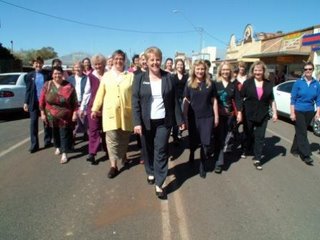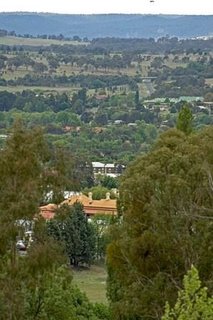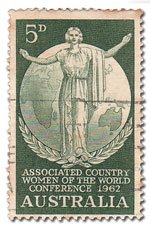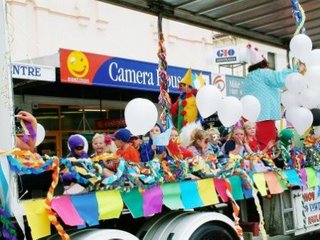 Photo:
Photo: the birds of Bradley Street
Located on the Northern Tablelands of NSW at an altitude of 1,320 metres, Guyra (population 2,200) is one of the highest if not the highest town in Australia.
Like a number of our inland towns, Guyra went through difficult times because of rural downturn combined with closure of the local abbatoir. Shops closed, house prices collapsed, people left.
Guyra fought back and has been going through an economic resurgence due in part to a remarkable group of women - the birds of Bradley Street (Guyra's main street) - including a number of tree changers.
Two and a half years ago, Leanne Emmerton bought the
Guyra Emporium, a long-established business housed in what was previously the Arcadia Theatre.
The Emporium sells furniture, camping gear, hardware, giftware, homewares and toys. Since taking it over, Leanne has renovated and introduced news lines of stock and given the place what she calls a woman's touch.
"It was previously owned by the same family for 25 years, basically run by a father and son, and I really don't think the store had seen a duster in years", Leanne recalled.
She is certainly getting positive feedback from the out-of-towners. One Sydney resident who shopped there told her that he would have had to shop in 10 different places to get everything he bought there that day!
Melbournite Julie Mills shifted to Guyra with her husband and young son in 2004 on a 12-month trial basis and bought an old department store to set up
Black Sheep Wool'n'Wares. The business is now thriving and Julie hasn't looked back.
The store stocks wools, knitting patterns, woollen clothing and soft toys, and is a key element of Guyra's unique village shopping precinct.
In 2004, Grace Kane, a Guyra local for the past 15 years, established
gGs, a family department store and boutique, with the aim of creating a destination rather than just a retail store.
"I was running the newspaper and I actually felt the town was quite sad," Grace recalled. "It was a dream of mine to buy the store and make the town come alive."
gGs is a historic attraction in itself, as one section of the store is located in the original Guyra Refreshment and Tea Rooms, built in 1900. Much of the store contains renovated or recycled items from its past life as a family run general store.
Nicole O'Malley Jones opened her
Fork and Spoon Cafe and Pantry in November 2005 after she and her husband Stephen Earl decided that Guyra had great potential for growth.
The couple, who relocated to Armidale five years ago, have 20 years experience in the hospitality industry in Brisbane, Sydney and London.
"We found the prices appealing in Guyra, saw that employment was good and believed there was a market for the gourmet products we stock here, as well as the cafe", Nicole said.
Nicole has introduced some new features to her business, like a tealeaf reader twice a week, and traditional high teas. It is quite likely she will open the cafe for special dinner functions in conjunction with the recently established Guyra Theatre Group.
A longer-term tenant of Bradley Street is the
Guyra Adult Learning Association (GALA) which has been operating for 23 years.
GALA offers a range of courses to adults, both vocational and leisure-oriented, and recently expanded its services into Armidale.
Other female-owned businesses in Bradley Street include:
JoJos on Bradley, a cafe owned by Jo Burey; the
Body and Soul Sanctum, opened in May 2006 by Benita Filipovich; Jenni Jackson's
Jenni Jackson Guyra Pharmacy; and a
naturopath clinic run by Rene Lockrey.
In Jenni Jackson's view women are the primary consumers so it's been good to see so many businesses in Guyra run by women.
"I think women have that retail focus as well as compassion and understanding for their customers, which works really well, particularly in a country town."
Guyra's development has been further aided by the
Costa Group's $36 million hydroponic tomato growing operation attracted to the town by the availabilty of land, clean air and water. This began just over 12 months ago, is now in its second stage of construction and when complete is expected to employ up to 200 people.
Guyra Shire Mayor, Robyn Jackson, said the fact that women have really taken the bit between the teeth and made things happen both personifies the area and demonstrates their self-belief.
"There were so many empty shops a while ago and I think their presence actually inspired these women to see their potential", Cr Jackson said.
"Now you don't have to leave town to find luxury items, and shopping has become more of an experience in itself. I have had visitors from out of town giving me positive feedback about browsing through the shops, then enjoying a coffee afterwards."
Location DetailsGuyra is on the New England Highway and is well located in terms of access to other centres.
Armidale with its major educational facilities including the University of New England is only 30 minutes away by car. Other nearby centres include Inverell (one hour ten minutes ) and Glen Innes (45 minutes). There are a number of nearby national parks including the New England National Park (one hour 20 minutes) and Dorrigo (one hour 30 minutes).
The nearest beach is two hours 15 minutes away via Dorrigo and the beautiful Bellinger Valley. Brisbane (five and a half hours) and Sydney (seven hours) are further by road, although the nearest major airport is only 30 minutes away at Armidale with plenty of free parking.
Further information on Guyra businesses can be obtained from Robyn Ryan, Guyra Shire Council's Economic Development Manager, (02) 6779 1577 or visit the Guyra Shire Council web
site.











